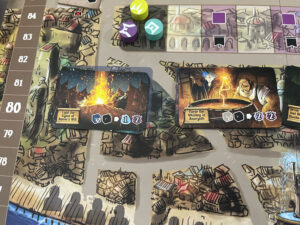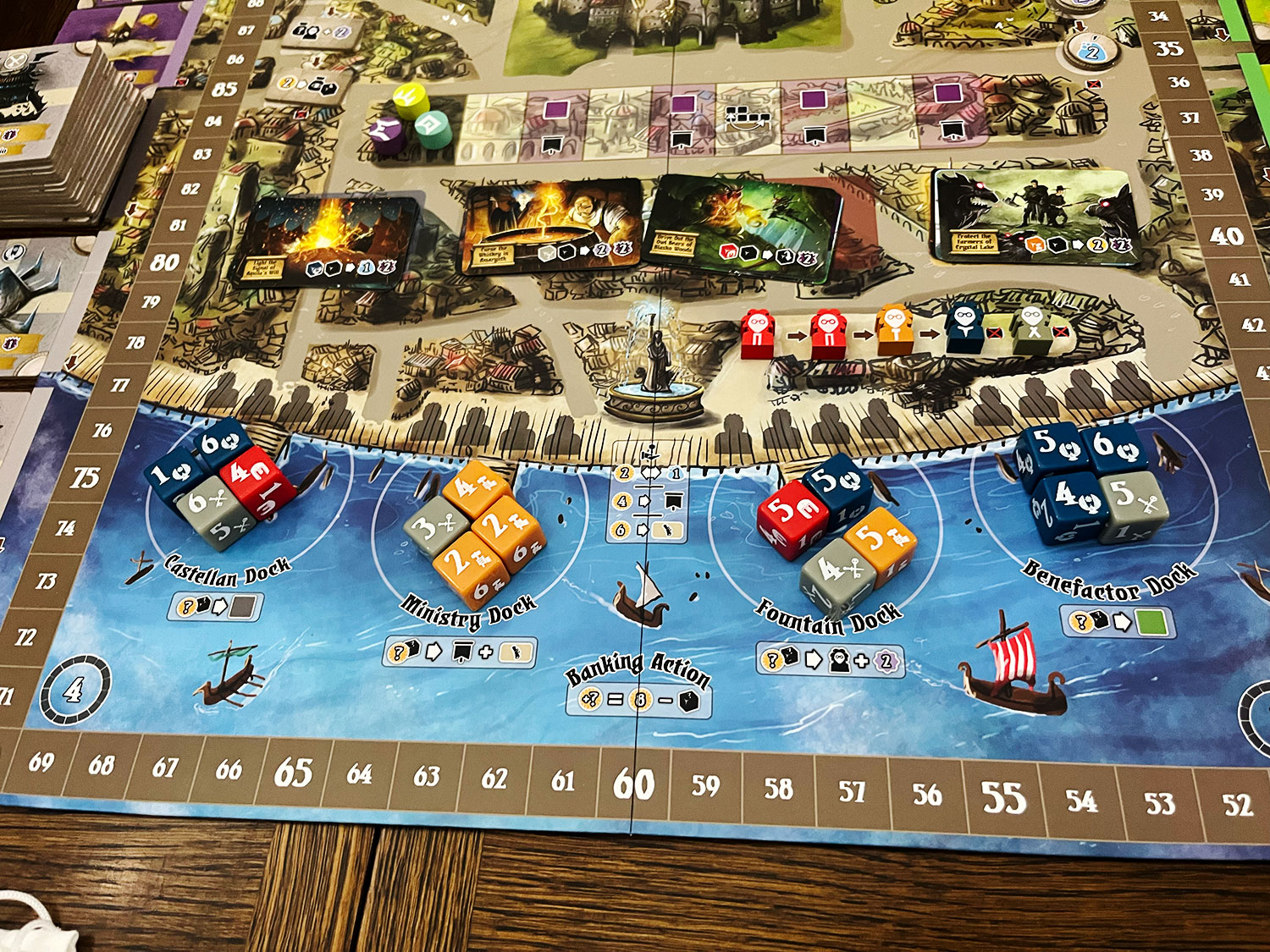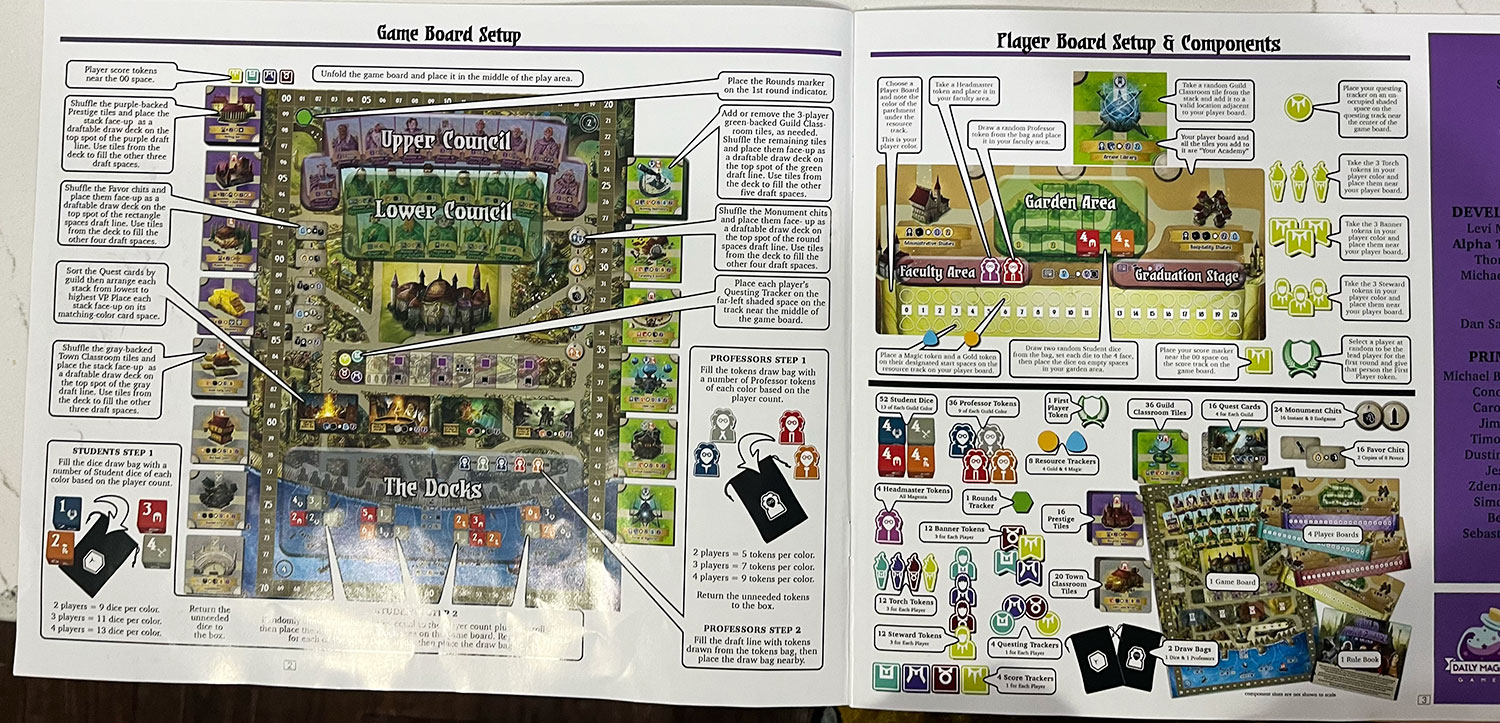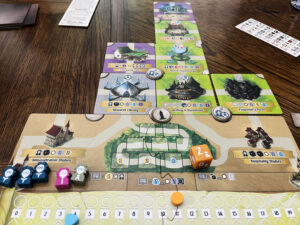 In Guild Academies of Valeria, your goal is to build the greatest Guild Academy by hiring the best professors and creating a fostering environment to train the right students to complete dangerous and rewarding quests. Along the way, you must gain influence over the ministries in the town council and earn favors to help on this mission.
In Guild Academies of Valeria, your goal is to build the greatest Guild Academy by hiring the best professors and creating a fostering environment to train the right students to complete dangerous and rewarding quests. Along the way, you must gain influence over the ministries in the town council and earn favors to help on this mission.
Guild Academies of Valeria is published by Daily Magic Games, and designed by Stanislav Kordonskiy. The game supports 1-4 players and takes about 90-120 minutes to play.
Gameplay Overview:
Guild Academies of Valeria takes place over four rounds and each round has four phases: Recruitment, Education, Questing, and Restoration.
Recruitment phase: During this phase, each player, in turn, sends their three Stewards, one at a time, to one of the four docks to draft a student die and perform the dock’s action, the banking action, and possibly an extra action.

The student dice are rolled at the start of the turn and are randomly placed on each dock. The students are in one of four guilds: Red die = Soldier, Gray die = Shadow, Blue die = Holy, and Orange die = Worker. The student’s cost is gold equal to the number on the die drafted (1-6).
Dock Actions:
- Castellan Dock – Draft one Town Classroom tile to your Academy. This allows you to train more students and if you complete a pedestal in your academy gain a monument chit which gains you professors, allows you to manipulate dice, gain gold, or end game scoring bonuses.
- Ministry Dock – Place a banner token on a Lower Council Seat, which gives you discounts on tiles or professors or allows you to make dice of one color wild, or the dock action allows you to move a banner to another Lower or to an Upper Council seat, which gives you bonus end game scoring. You also receive a favor chit which gives you nice bonuses.
- Fountain Dock – Draft one of the randomly selected professors and gain two points to use to immediately educate one or two students (raising their die’s numbers).
- Benefactor Dock – Draft a Guild Classroom tile to your Academy and again if you complete a pedestal in your academy gain a monument chit.
Banking Action – Instead of taking a dock action you may receive 8 gold minus the die number of the student drafted.
Education Phase: Assign your professors and appropriate students to the classroom tiles in your Academy. Follow the instructions to educate your students and advance the dice the appropriate amount, you may spend magic or use monuments and favors to further educate your students. The goal is to graduate your students by raising the number on their die to greater than 6.
Questing Phase: Assign the graduated students to the quests based on the Guild requirements for quest completion and earn victory points, prestige tiles, and other bonuses.
Restoration Phase: Just resetting the game for the next round or if it is the 4th round calculate the end game scoring. End-game scoring is based on Prestige tiles and the Upper Council seats that bear your banner. The winner is obviously the player with the most victory points.

Game Experience:
Some games have rulebooks that are welcoming and make it seem like you are about to have a good time. Then there are the first 2 pages of Guild Academies of Valeria’s rulebook. See photo. There are 24 speech bubbles explaining set-up and on the second page, the print is so small I had to borrow my mom’s readers to learn how to set the game up. I was very frustrated by this game’s rulebook, not only by the small print, but also by not naming the four guilds until the appendices, which limited the theme from meaning anything, and a typo that made me select the wrong minister to influence during my first play, as the rule book lists a Minister of Urbanization, but it’s really the Minister of Culture, and it took me way too long to figure out this error.

If you have read any of my reviews, this game hits all of the sweet spots for me. I love worker placement games, with Lords of Waterdeep being my favorite. I enjoy the luck of die-rolling in Dice Throne. I generally prefer multiplayer solitaire with very little “take that” as I play many games with my kids. I own a dumb number of “city” building games: Dream Home, Subdivision, Between Two Castles, Siliconvania, Santa Monica, and more. I still regularly play Dice Kingdoms of Valeria, so this is a universe I enjoy. However, this is not a game I enjoy enough to bring back to the table over any of the games listed above. If you have never played any of the games mentioned above, then you may like this game more than I do.
All of that being said, the game is kind of fun to play. You need to determine which dice/guilds are the most important to you, giving it a bit of an Azul feel in the drafting portion of the recruitment phase. You need to determine if you have the right professor, classroom, favors, monuments, and magic combination to graduate the correct students to complete the quests and then hope that the prestige tile that you want is still there when it is your turn to draft after completing the quests.

Like in many drafting games, I enjoy the need to be aware of both your and your opponent’s scoring strategies and draft order to ensure you can complete your goals. This game has no ability to attack your opponents, so without this awareness, your best tiles, students, and professors can be drafted out from under you. However, here the game struggles by having too many ways to score, rules to remember, and bonuses to adjust your tactics to ever make it feel like you truly have as much control as would be needed to be a strategy game. Also, for my taste the game takes a little too long, as our plays were north of the 120 minutes on the box, but much of that came down to needing to revisit the dreaded rulebook.
Solo Mode: There is a solo mode called Guild Rivals! In it, you compete against “The Rival,” a simulated opponent guided by randomized action cards and adjusted rules to smooth their play and increase the challenge. That’s a direct quote from the rulebook and is as close as I got to playing the Solo mode. As I have mentioned in every review, I am not a solo board game player and if I were, this is not the game I would start playing solo, that would be Final Girl… which I still won’t likely play.
Final Thoughts:
Guild Academies of Valeria combines worker placement, drafting, the luck of dice rolls, and city (school) building into a mostly multiplayer solitaire game that is an example of the sum of the parts being less than the whole.
Final Score: 2.5 Stars – When I want to play a worker placement game where I need to get the right colored cubes to go win a quest, I am going to pick Lords of Waterdeep 10/10 times and sadly Guild Academies 0/10 times. That being said it is a relatively fun game, especially for people who can read small print.
 Hits:
Hits:
• The art is great from box art to all of the components
• With multiple ways to score, different strategies can work to win, but as you will see this is both a hit and a miss.
• The student’s level is determined by a die roll and the randomness of their placement changes the strategy every round and every game.
Misses:
• The Print is too small in too many places: the setup section, the appendices, and player guides are the most offensively small and the orange and red colors in the council section are too similar, especially for those who are red-green color blind.
• Probably too many ways to score, I know this is a weird complaint, but the multiple unrelated strategies to score took me out of the theme and made it less of a strategy game.
• After many games, I still find the guilds irrelevant to the game (so much that the rulebook never identifies them until the appendices). The magic doesn’t feel magical, but rather just something to use to educate students and turn into gold (Alchemy alone is not a reason to learn magic in a game, but if I could do it in real life, I would be down.)





















